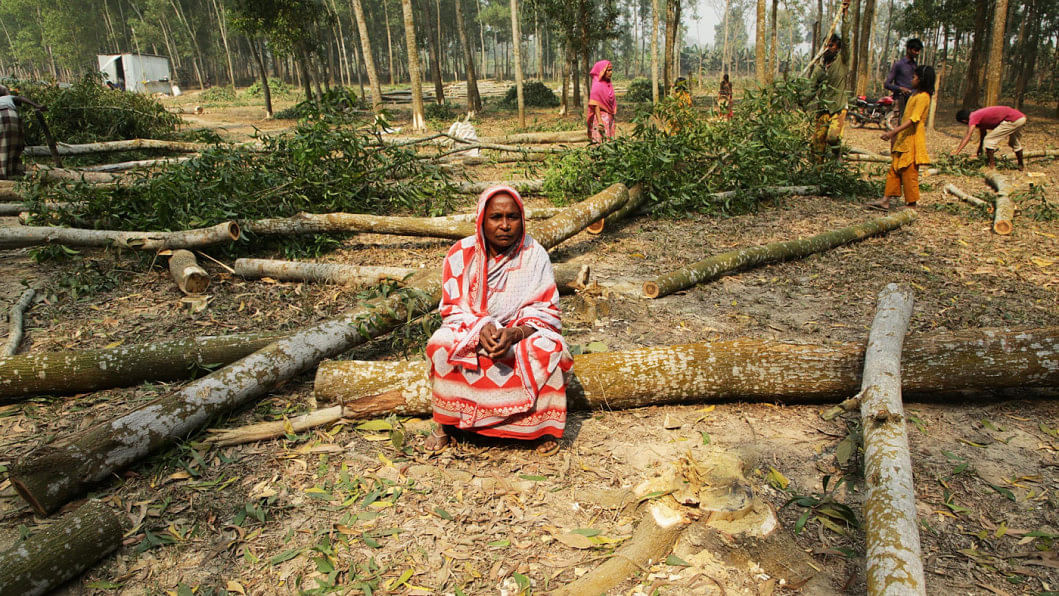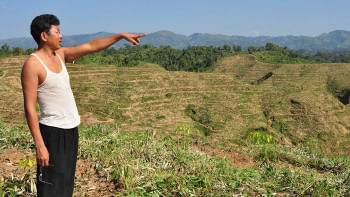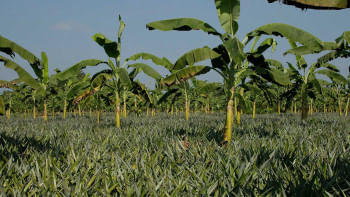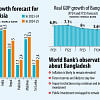How forestry projects destroy forests

A huge tractor was roaring on a large plot in Dokhola Beat in Dokhola Range in Madhupur sal forest on January 17. It was ploughing the forest land right after harvest of exotic acacia, under the social forestry scheme. The vast area had stands of acacia even a month or two ago. Then, all of it was auctioned and felled. Attached to this plot lies a huge newly planted pineapple orchard on plots harvested just six months ago and plots that have just been felled. No "social forestry" tree has yet been planted in these plots!
In addition to 45 percent of the sale proceeds after harvest, social forestry participants are allowed to cultivate crops on the condition that they not plough the land, as per the social forestry agreement.
Social forestry is a controversial scheme to grow fuelwood, initiated in Madhupur sal forest and other forest areas back in 1989-1990 with funding support from Asian Development Bank (ADB) under the Thana Afforestation and Nursery Development Project (TANDP). Patches of natural sal had been cleared to make way for social forestry. In the first rotation, exotic eucalyptus was a major species. The second ADB-funded plantation scheme, Forestry Sector Project (FSP), was implemented amid severe criticism that such plantation projects promote monoculture and require clear-felling at the end of a 10-year rotation, which has led to massive damage to the natural ecosystems.
Though eucalyptus was eradicated from the public forest land starting on the second rotation, social forestry continues at a very high cost to natural ecosystems.
The natural sal forest patches have been replaced by monoculture plantation of acacia on around 5,000 acres in Madhupur. According to the forest department, from 1981 to 2022, it has established block or woodlot plantations on 105,283.03 hectares of land. These plantations, under a number of projects, have had increasingly severe effects on the local environment for years. Madhupur sal forest (still gazetted forest land) has now become pineapple, banana, papaya, lemon, and turmeric orchards.
On public forest land social forestry is a plantation practice in which the local poor people are to be selected as participants to get plots – one ha each. Under such a public forest plantation model, from the fourth rotation, a plot is reduced to one acre to accommodate more participants. This is called co-management, a controversial arrangement that has caused massive destruction of the natural vegetation in the sal forest areas and other public forest patches.
ADB provided funds for two rotations in Madhupur and elsewhere. Then, in 2005, it ceased funding any forestry projects in Bangladesh and other Asian countries. A top official of the bank confessed to me that they had realised the harm the plantations have caused.
The co-management model of social forestry comes with certain conditions. A participant must be a poor ethnic person or forest villager, member of disadvantaged or backward communities, destitute woman, insolvent freedom fighter or their descendant, landless or someone owning less than 50 decimals of land. A key qualification for a participant to get priority selection is if s/he resides within one kilometre radius of the plantation plot.
But has the forest department, the implementing agency of social forestry, ensured that these conditions in selecting participants have been fulfilled? "Largely not," is the common response of the locals. "Many social forestry participants are not genuinely poor, disadvantaged, and landless. They are well-off," says Eugin Nokrek, president of Joyenshahi Adivasi Unnayan Parishad (JAUP).

Social forestry indeed has a positive impact, particularly in greening rural areas. But it had a tragic start in Madhupur and other forest patches in 1989-1990. It was supposed to be introduced in degraded and denuded areas. But, to the great disappointment of locals, patches of natural forests were cleared to accommodate plantations of exotic eucalyptus and acacia.
Moreover, the first rotation of the social forestry plantation was a disaster. Most of the planted trees disappeared before reaching the harvest period seven to 10 years later. A forest that had existed for thousands of years was thus replaced by a short rotation plantation of exotics.
Meanwhile, a local businessman, who is a participant in the Madhupur Range and is certainly not poor, defended himself: "The trees of the first rotation were plundered because the poor participants could not protect them from forest thieves. From the second rotation, 'strong' men like us were selected and we are protecting the plantation plots."
Allegations of corruption in the selection of participants for social forestry are widespread. The forest department officials, however, deny the allegations against them.
One facet of social forestry is financial gains. One widow participant of a one-hectare social forestry plot in Madhupur Range was very happy during harvest time this year. Her plot has been auctioned for Tk 1,122,000 ($11,220), of which she will get 45 percent, the forest department 45 percent, and 10 percent will go into a fund for future planting.
In the initial years of a rotation, businessmen rent social forestry plots from the participants to grow pineapple and spices. While the participants earn an income from this deal, the businessmen pocket handsome profits.
The saddest part of social forestry in Madhupur is that, what used to be natural forest patches even in the 1980s are now covered by high-value agricultural crop fields, which politically connected and influential people benefit from the most. Social forestry in Madhupur and elsewhere has led to the wholesale destruction of forest ecosystems.
Not that the forest department and dominant finance providers (ADB and World Bank) do not know of the damage that plantations have caused to forest ecosystems. And they do have a mitigation plan. As I have mentioned above, ADB has completely withdrawn from the forestry sector in Bangladesh and Asia.
But the World Bank (WB), which had cut down financing the forestry projects, has returned with possibly the largest ever forestry project in Bangladesh, the Sustainable Forest and Livelihood (SUFAL), for the restoration of 78,930 ha of forest through collaborative management with around 40,000 beneficiaries in 28 districts who traditionally depended on forests but were seen to be a threat to the forests.
The idea of Collaborative Forest Management (CFM) is to restore lost forest species and help forest-dependent people.
"We are becoming successful in restoring and regenerating forests on 78,930 hectares of forest land by dint of the Site Specific Plan (SSP)," claims a high-level official of the forest department team overseeing SUFAL.
But Madhupur locals have a different assessment.
"The forest floor was unnecessarily cleared of natural vegetation to plant trees. This has further threatened the surviving wildlife and insects," says Ajoy Mree, a Garo elder from Gachhabari village. "The trees under the shade of standing trees have little chance to survive. The remaining natural forest should be left untouched."
One can see colourful signboards under the project describing the site, specific plantation, and names of species planted in Madhupur national park and other protected parts. But there is little sign of improvement in the vegetation. Pineapple plantation has made its way onto some of the plots.
Soon after a plot is cut, the stumps are hastily uprooted and huge tractors roll in to quickly prepare the land for pineapple plantation. Who is doing this? "Politically powerful gangs who rent the land from participants in social forestry," say the locals. What can SUFAL and its beneficiaries do to contain this? "Very little or nothing," they say.
"Strong political support for high-value agricultural crops such as pineapple, banana, papaya, and spices are the biggest problem," says a former chief conservator of forests. "Political gangs are destroying the forest."
"We will be successful in protecting our forest only with the right political decisions," whispers a forest official working with SUFAL.
However, a top WB official, though happy about SUFAL, is not ecstatic about forest department officials. "The forest department should pay greater attention to us," he says.
The blame game over factors that led to all the devastation we see in the sal forests of Madhupur and elsewhere does not help. The government, international donors, and other parties with decision-making power must recognise their failures, prevent the situation from getting worse, and contribute to improving the climatic environment.
The forest department and our political heavyweights undoubtedly benefit from forestry projects and assist the WB to justify its comeback in the forestry sector in a big way. What they should not forget is how the forest extraction and forestry projects from British colonial times – which promoted plantations and co-management – have had devastating effects on our forest ecosystems. We would like to see what is missing: passionate and careful attention being paid to ground realities.
Philip Gain is a researcher and director at the Society for Environment and Human Development (SEHD). The author would like to acknowledge the contributions of SEHD researcher Fahmida Afroze Nadia and Madhupur's Probin Chisim, who assisted him in gathering information on social forestry.

 For all latest news, follow The Daily Star's Google News channel.
For all latest news, follow The Daily Star's Google News channel. 










Comments